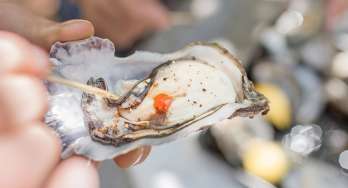Why do people go to Waipu Caves?
Visitors come to Waipu Caves in New Zealand for a close-up look at glowworms in a natural cave setting, with no entry fee or commercial infrastructure.
The caves are part of the Waipu Caves Scenic Reserve and offer a mix of cave exploration and outdoor walking. The main chamber is easy to access, with large open spaces, shallow water, and impressive stalactite formations. A short walk uphill leads to bush trails and views across the surrounding limestone landscape.
For many, the appeal lies in the experience itself – scrambling through rocks, listening to underground streams, and discovering glowworms in their natural habitat. It’s less polished than commercial caves, but that’s part of the attraction.
How long should I spend at Waipu Caves?
Visiting the caves is one of the most popular things to do in Waipu, Northland. Most people spend 1 to 2 hours exploring. That’s usually enough time to:
-
Walk into the main chamber and view the glow worms
-
Explore the limestone formations
-
Take the short bush walk or have a break at the picnic area
If you’re interested in photography, exploring side passages, or simply want to take your time, you could spend up to half a day here – especially if combining it with the nearby walking track or a relaxed lunch stop.
How long is the Waipu Cave Walk?
There are two parts to explore at Waipu Caves – the underground route through the glow worm-filled chamber, and the walking track through the surrounding bush reserve. Both are short and manageable but offer quite different experiences depending on how much time you have and how adventurous you’re feeling.

Inside the caves
The accessible part of the cave system is roughly 100 to 200 metres, depending on how far you choose to go. Progress is usually slow due to the uneven, muddy ground, low light, and the time spent looking at formations and glow worms. Most visitors spend 30 to 45 minutes inside.
Outside the caves
The Waipu Caves Track is a 2 km (each way) walk that leads uphill through regenerating bush to a scenic viewpoint. It takes around 1.5 hours at a steady pace and offers a good leg stretch with views over karst rock features typical of this landscape.
How to get to Waipu Caves
From Auckland: Take State Highway 1 north towards Whangārei. The total drive is around 140 km, or 1 hour 45 minutes to 2 hours, depending on traffic. Before reaching Waipu, turn left onto Waipu Caves Road. Follow this for about 11 km – the last part is a gravel road, so take it slowly, especially in a campervan.
From Waipu township: Head north on SH1 briefly, then turn left onto Waipu Caves Road. Follow the same route inland for 15–20 minutes. The caves are well signposted, but road conditions near the end may be narrow and winding.
Best time to visit Waipu Caves
Best time of year: Waipu Caves can be visited year-round, but summer and early autumn (December to April) offer drier ground conditions and easier access along the gravel road and bush tracks. In winter and spring, expect more mud, slippery surfaces, and cooler temperatures inside the cave.
Glow worms are present in all seasons, but access and comfort may vary depending on recent rain and road surface.
Best time of day: For the best glow worm visibility, go early in the morning, late afternoon, or on overcast days when the cave interior feels darker by comparison. If you’re entering in bright daylight, allow your eyes a few minutes to adjust before trying to spot the glow.
For photography or to navigate the track around the cave entrance, midday to early afternoon offers the best natural light.
Weather at Waipu Caves
The area around Waipu has a mild, temperate climate:
-
Summer (Dec–Feb): 22–25 °C
-
Autumn/Spring: 16–22 °C
-
Winter (Jun–Aug): 10–15 °C
Rain is possible in any season, and the cave interior can be damp and cool year-round. Wear sturdy shoes and consider bringing a jacket and headlamp. If it’s recently rained, the track and cave entrance may be muddy or slippery.
Waipu Caves safety tips
Waipu Caves is an unguided, natural environment, so caution is essential. The cave floor can be uneven, wet, and slippery, especially after rain.
-
Wear sturdy footwear with good grip.
-
Bring a reliable light source – a headlamp is ideal, and a backup torch is recommended.
-
Avoid touching limestone formations or disturbing glowworms.
-
If exploring beyond the main chamber, go with others and let someone know your plans.
-
Take care near water and check conditions before entering during or after heavy rain, as flooding may occur.
Best place to park your campervan at Waipu Caves
There is a free car park at the entrance to the Waipu Caves Scenic Reserve. It’s suitable for campervans during dry conditions and includes public toilets. However, there are no dump stations or drinking water on site.
During wet weather, the parking area may become soft underfoot, so take care when manoeuvring a heavier vehicle. Arriving earlier in the day is a good idea, as parking space is limited.
Road trips that pass through



